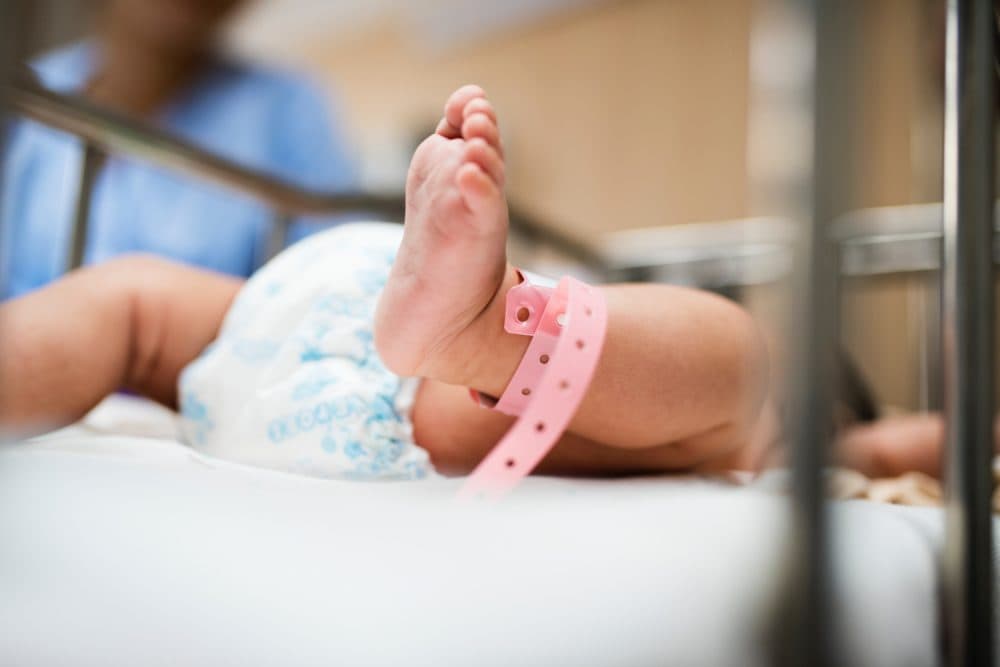Advertisement
U.S. Birth Rate Drops To Lowest In Decades
Resume
With Ray Suarez
The U.S. birth rate dips to a 30-year low. Shifting attitudes about motherhood is just one of the reasons why. We'll look at what's behind the drop.
Guests:
Janet Adamy, news editor at the Wall Street Journal who covers demographics. (@janetadamy)
Stephanie Coontz, professor of history and family studies at The Evergreen State College. Author of “Marriage, a History: How Love Conquered Marriage” (2005). (@StephanieCoontz)
Emilio Parrado, professor of sociology at the University of Pennsylvania who studies the U.S. Hispanic population, international migration, and demographics.
Highlights:
On the drop and the economy:
Adamy: "The numbers are pretty striking. We did a chart going back a hundred years, the 2017 birth rate: 60 babies per 1,000 women per year. That's about half of what it was in the 1960s. So it's a pretty dramatic drop.
This really all started with the 2008 recession. There was essentially a fertility crash after that. What we know from the research is when the economy gets bad, people put off having babies. But since then, the demographers I've spoken to estimate that there are 4.8 million fewer babies that have been born as a result of this fertility rate.
This imbalance creates a lot of pressure on social security, and Medicare. You don't have the young workers paying into that program. Those programs face a lot of pressure.
"Even though the economy is quite a bit better than it was 10 years ago, you still have these lasting economic scars. For a lot of these people, it's millennials who have put off having children."
Janet Adamy
Even though the economy is quite a bit better than it was 10 years ago, you still have these lasting economic scars. For a lot of these people, it's millennials who have put off having children. They are still digging themselves out of student loan debt, it's become harder to buy a house, they look at the cost of childcare which is increasing beyond the rate of inflation. And they may have a good job and a good income now, but they haven't dug themselves out of that hole that they found themselves in after the recession.
On the gap between wanting children and reality:
Coontz: "I think the most important and concerning thing about this is not the number of people who are voluntarily childless, but the tremendous gap between the number of children women said they wanted to have and the number that they will probably have. Early this year, the gap reached its highest level in 40 years. I think we need to think very seriously about what it is that pushes people into this kind of 'delaying.'"
How immigration fits into the picture:
Parrado: "The reality is that what has changed is the dynamics of immigration. Since 2007, we have seen a dramatic change in immigration patterns. Immigrants are no longer coming from primarily Latin America, they're coming from Europe, Canada, Africa and Asia... There's a connection between immigration and fertility. When people move to the U.S., there's a tendency to have a child.
The [current] political context, the lack of easy access to health care, uncertainties of job stability that compromises family life... All of those political and social changes are contributing to low fertility.
The most striking feature is that the fertility rate is really declining among immigrants. Among native-born populations, the number of births has declined around 8%, which is what you'd expect due to the recession. But for immigrants, it has actually declined twice as much (number of births between 2007-2015)."
On the difference between birth rate and fertility rate:
Suarez: "Birthrate is a measurement of the entire population, while fertility rate is a measurement of a group of individuals in the population. Birthrate is expressed in relation to a time interval, while fertility rate is expressed in relation to the number of females in the reproductive age."
From The Reading List:
The Wall Street Journal: "U.S. Births Hit Lowest Number Since 1987" — "American women are having children at the lowest rate on record, with the number of babies born in the U.S. last year dropping to a 30-year low, federal figures released Thursday showed.
Some 3.85 million babies were born last year, down 2% from 2016 and the lowest number since 1987, according to the Centers for Disease Control and Prevention’s National Center for Health Statistics. The general fertility rate for women age 15 to 44 was 60.2 births per 1,000 women—the lowest rate since the government began tracking it more than a century ago, said Brady Hamilton, a statistician at the center.
The figures suggest that a number of women who put off having babies after the 2007-09 recession are forgoing them altogether. Kenneth M. Johnson, senior demographer at the University of New Hampshire, estimates 4.8 million fewer babies were born after the recession than would have been born had fertility rates stayed at prerecession levels."
There have been baby booms and baby busts through American history… maternity wards and midwives weren’t very busy after the crash and the Great Recession. But when the economy healed, the birth rate stayed low, and in 2017, once again, American births dropped to another thirty year low. What’s up? Delayed marriages? Costs? A longer road to adulthood? A baby bust in the midst of an immigration debate.
This hour, On Point: America’s empty cradles.
- Ray Suarez
This program aired on May 23, 2018.